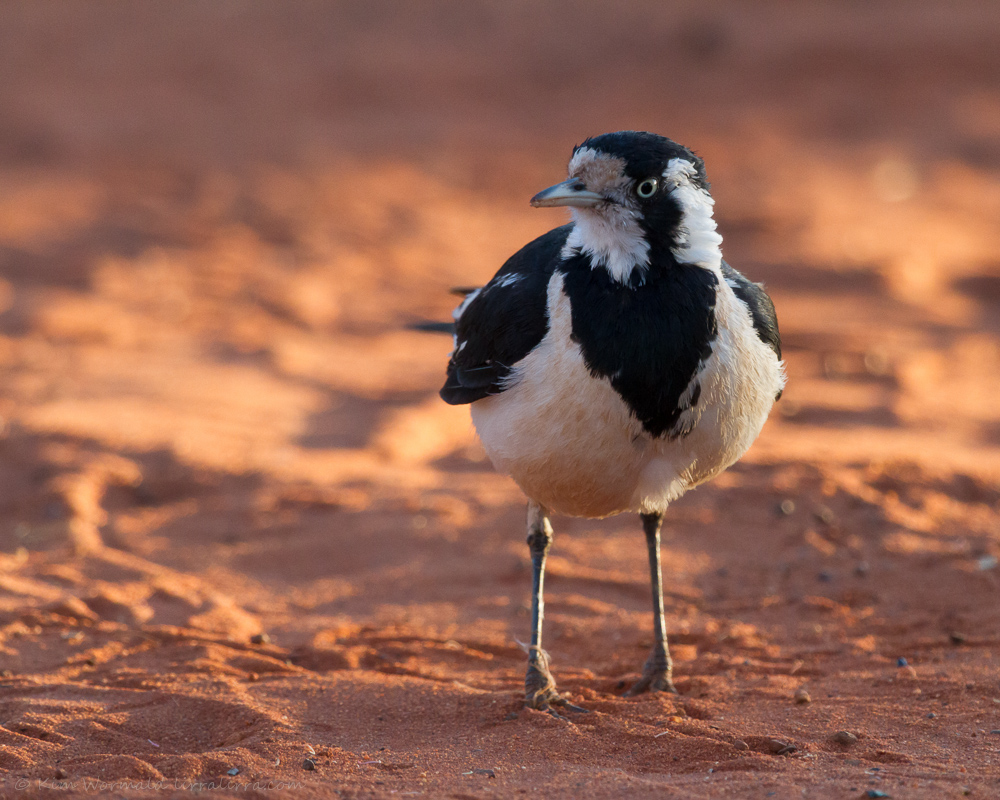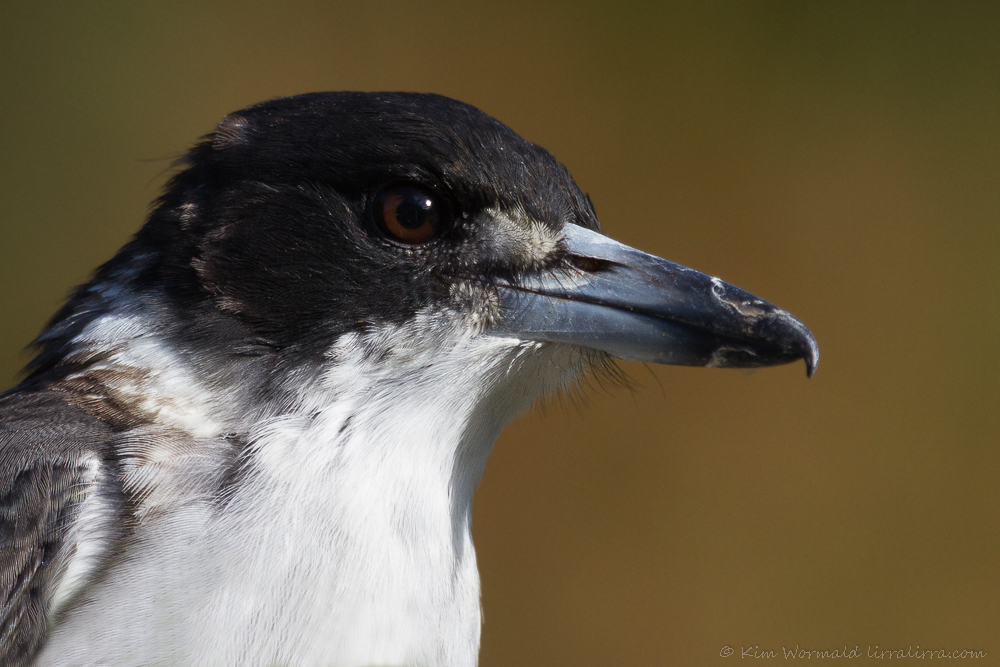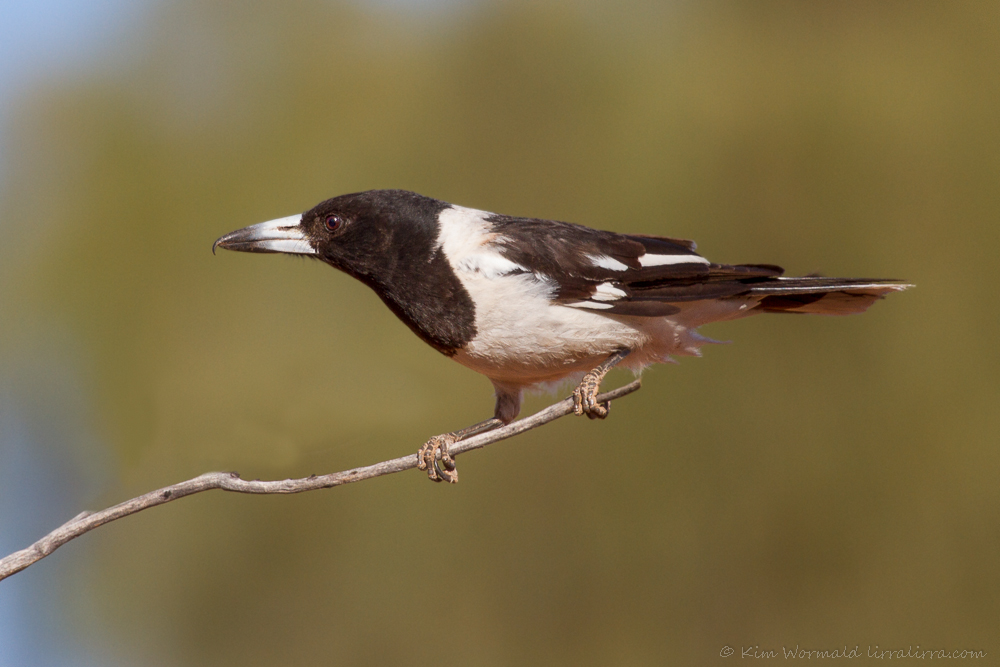Magpies are butcherbirds but butcherbirds aren’t magpies, and Magpie-larks aren’t magpies or larks. Australian Magpies are loved for their melodic carolling and feared for the way a small minority swoop during the breeding season. There are several magpie sub-species and despite being well-known they are often muddled with butcherbirds and Magpie-larks.
 Australian Magpie (Cracticus tibicen) Black-backed Magpie
Australian Magpie (Cracticus tibicen) Black-backed Magpie
Canon 7D, 100-400mm L IS USM, 1/640, f/5.6, ISO 125, focal length 400mm
I found this Black-backed Magpie foraging in the Red Centre following a grass fire. I liked the way its colouring matched the landscape: black feathers and burnt wood, white feathers and ashes, red-brown eye and desert sands. Black-backed Magpies are abundant throughout much of Australia but around home I see the White-backed race where the males have white backs, and females and juveniles have mottled grey backs.
 Australian Magpie (Cracticus leuconota) – White-backed Magpie
Australian Magpie (Cracticus leuconota) – White-backed Magpie
Canon 7D, 100-400mm L IS USM, 1/640, f/5.6, ISO 320, focal length 400mm
Magpies are members of the butcherbird family but unlike butcherbirds they forage on the ground, running to catch large insects and probing with their strong bills for worms and grubs.
 Magpie-lark (Grallina cyanoleuca) (female)
Magpie-lark (Grallina cyanoleuca) (female)
Canon 7D, 100-400mm L IS USM, 1/640, f/5.6, ISO 1600, focal length 400mm
Magpie-larks are smaller than magpies, with finer bills and light irises. Despite their name they are neither magpies nor larks. Females have white faces while males have black faces and white eyebrows. It’s sad to see that this is another bird with human rubbish tangled around its foot. This image was also taken in the Red Centre, I like the way the desert sand, the pied plumage and the early morning light complement each other.
 Grey Butcherbird (Cracticus torquatus)
Grey Butcherbird (Cracticus torquatus)
Canon 7D, 100-400mm L IS USM, 1/320, f/5.6, ISO 125, focal length 250mm
I was lucky to get close enough for this image of a Grey Butcherbird with its distinct white underparts, brown eye and hooked bill. They have beautiful songs and are striking looking birds but their habit of taking nestlings and hanging them in the fork of a tree is not too pleasant. The male and female can only be identified by size, with the males being slightly larger. This bird was calling to its partner who was answering from about 20 metres away. I loved seeing it raise it’s head and sing but it was even more obscured by leaves and I didn’t get an image worth sharing. The background is an Australian Blackwood (Acacia melanoxylon) which is covered in curly brown seed pods at this time of year.
 Grey Butcherbird
Grey Butcherbird
Canon 7D, 100-400mm L IS USM, 1/640, f/5.6, ISO 160, focal length 390mm
Until this butcherbird arrived I had been watching Silvereyes and Yellow-faced Honeyeaters that flew for cover when they realised they had company. There was a leaf across the bottom part of this image so I experiemented with cloning to see if I could make it disappear without ruining the image. I will not make a habit of this! It’s time-consuming and doesn’t seem right but it was good to explore Photoshop Element tools.
I don’t know if you can discern it in these images but the butcherbird’s eyes seemed to have a milky cast; they weren’t bright and clear and the catchlight looks odd. The reflection of the rising sun is sharp but the catchlight spreads to a film covering the bird’s eye. I researched cataracts in birds but they seem to be centred over pupils while this film covered the entire eye.
 Pied Butcherbird (Cracticus nigrogularis)
Pied Butcherbird (Cracticus nigrogularis)
Canon 7D, 100-400mm, 1/800, f5.6, ISO 160, focal length 400mm
The Pied Butcherbird adds to the muddle but is larger than the Grey Butcherbird and Magpie-lark, and smaller than the Australian Magpie. It can be distinguished from the Grey Butcherbird by its black bib. This image was taken in the Great Victoria Desert in WA where the species is referred to as a magpie.
Magpies, butcherbirds and Magpie-larks are all known to occasionally swoop on people and animals they perceive as threats. They do this during the breeding season to protect their eggs and nestlings. Magpies breed in the tree next to my garage and have never swooped, I hope I’m not tempting fate. I have spoken with people who have been swooped and it sounds like a frightening experience. The DSE has a web page regarding the issue, Swoop, which details many recommendations including wearing a hat or carrying a stick or umbrella above your head if you are passing through an area where birds are swooping.
Happy birding, Kim

Kim,
Your first image took my breath away, the light, the details and the pose of the bird. It also brought me back to mornings spent listening to the Magpies and Currawongs during the time I spent in Australia.
This is a delightful post, the information about the different species is terrific as are the photos.
Thank you Mia! I’m glad the post triggered happy memories for you. I was pleased that the Black-backed Magpie showed his black back so nicely while keeping a catch-light in his eye – very thoughtful of him 🙂